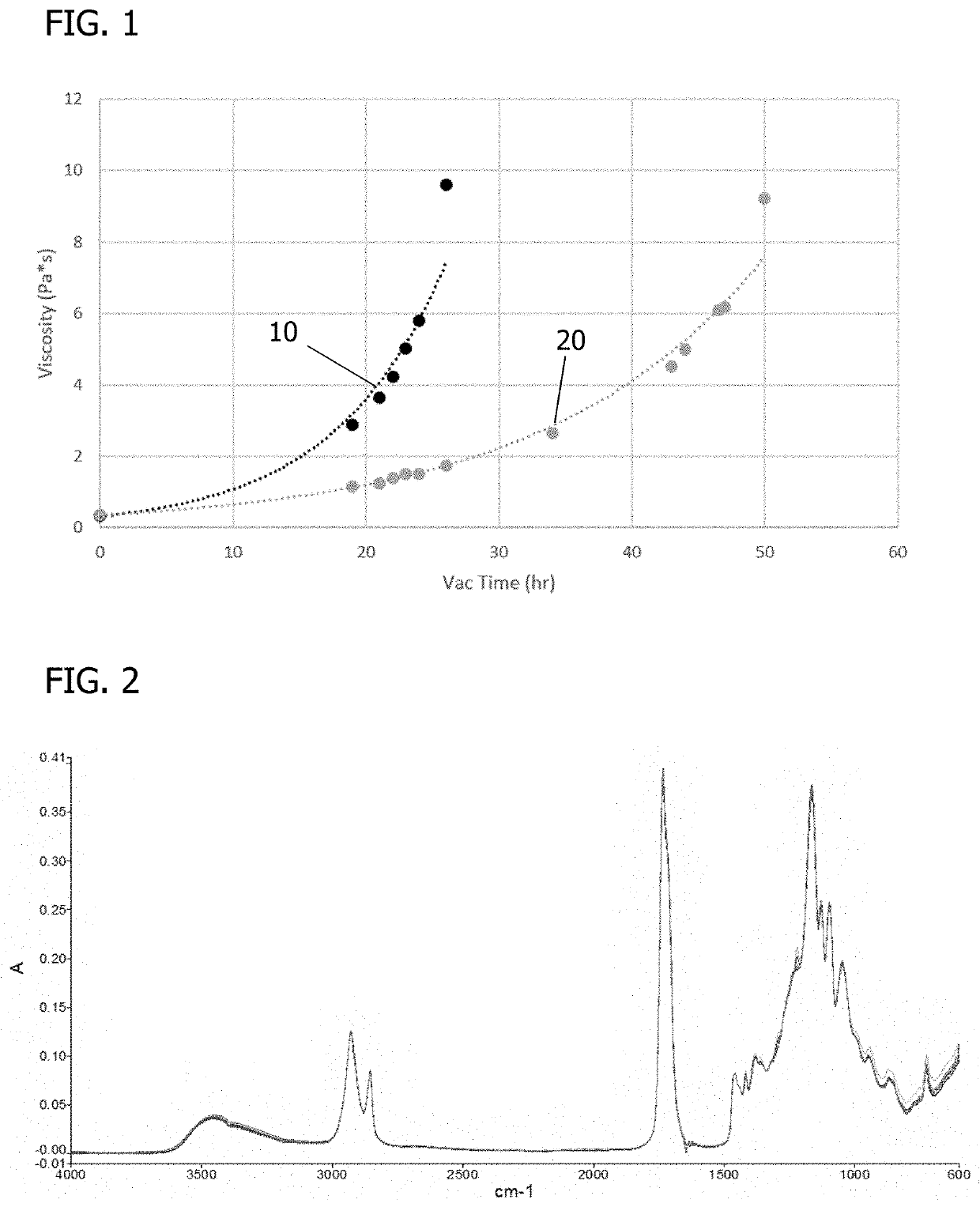Tunable, controlled-release, urethane-containing elastomers and processes of forming the same
a technology of urethane and elastomers, which is applied in the direction of additive manufacturing processes, prosthesis, heterocyclic compound active ingredients, etc., can solve the problems of large burst release and fast release rate, difficult to achieve high drug loadings that sustain release for more than 3 months, and large burst release and other limitations, to achieve the effect of high api loading
- Summary
- Abstract
- Description
- Claims
- Application Information
AI Technical Summary
Benefits of technology
Problems solved by technology
Method used
Image
Examples
example 1
[0173]PGS resins synthesized by a water-mediated process were compared to PGS resins synthesized by a non-water-mediated process. FIG. 1 shows the viscosity as a function of reaction time for the water-mediated process (10) compared to the non-water-mediated process (20).
[0174]PGS resins synthesized by a water-mediated process and PGS resins synthesized by a non-water-mediated process were characterized and analyzed. Four different batches of water-mediated PGS resins and four different batches of non-water-mediated PGS resins, having a weight-average molecular weight (Mw) over the range of about 10 kDa to about 50 kDa, were characterized. Table 1 shows the resulting data from the characterizations. Resins 1-4 were formed by a water-mediated process, and Resins 5-8 were formed by a non-water-mediated process.
[0175]
TABLE 1Water-mediated vs. Non-water-mediated PGS Sample DataMw by GPCZero-Shear ViscosityPolydispersityAcidSample(Da)(Pa · s)IndexNumberResin 1132753.069.98947Resin 222817...
example 2
[0179]Sixteen samples of PGSU films were formed by reacting each of Resin 1 through Resin 8 by combining and mixing each PGS resin with HDI at two different PGS:HDI mass ratios, 2.5:1 and 3.5:1, during film fabrication.
[0180]The crosslinking of each PGSU film was estimated by FTIR spectroscopy and a multiple linear regression (MLR) model that used the integrated area of peaks highly correlated with crosslinking density. The resulting estimated crosslinking is shown in FIG. 4 as a PGS:HDI mass ratio. The PGS:HDI mass ratio is related to the crosslinking density, as shown in Example 5. PGS:HDI mass ratio can be converted to NCO:OH stoichiometric ratio using the hydroxyl value of the PGS resin and the equivalent weight of OH and equivalent weight of NCO. For reference, 3.5:1 PGS:HDI mass ratio films are less crosslinked than 2.5:1 PGS:HDI mass ratio films. FIG. 4 shows that different resins demonstrate different crosslinking behaviors, in some cases having lower crosslinking than would...
example 3
[0182]The sixteen samples of PGSU films were tested to determine elastic modulus, with the results being shown in FIG. 6, and strain at break, with the results being shown in FIG. 7, as determined by tensile testing. As shown in FIG. 7, PGSU films did not break in some cases such that no strain at break data could be collected. In these cases, increased PGSU crosslinking led to a tougher polymer that did not break, as opposed to a more brittle polymer behavior that might have been expected.
PUM
| Property | Measurement | Unit |
|---|---|---|
| weight average molecular weight | aaaaa | aaaaa |
| temperature | aaaaa | aaaaa |
| molecular weight | aaaaa | aaaaa |
Abstract
Description
Claims
Application Information
 Login to View More
Login to View More - R&D
- Intellectual Property
- Life Sciences
- Materials
- Tech Scout
- Unparalleled Data Quality
- Higher Quality Content
- 60% Fewer Hallucinations
Browse by: Latest US Patents, China's latest patents, Technical Efficacy Thesaurus, Application Domain, Technology Topic, Popular Technical Reports.
© 2025 PatSnap. All rights reserved.Legal|Privacy policy|Modern Slavery Act Transparency Statement|Sitemap|About US| Contact US: help@patsnap.com



